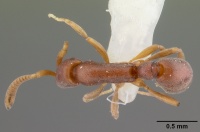Probolomyrmex bidens
| Probolomyrmex bidens | |
|---|---|

| |
| Scientific classification | |
| Kingdom: | Animalia |
| Phylum: | Arthropoda |
| Class: | Insecta |
| Order: | Hymenoptera |
| Family: | Formicidae |
| Subfamily: | Proceratiinae |
| Tribe: | Probolomyrmecini |
| Genus: | Probolomyrmex |
| Species: | P. bidens |
| Binomial name | |
| Probolomyrmex bidens Brown, 1975 | |
Known only from the holotype worker, nothing is known about the biology of Probolomyrmex bidens.
Identification
Brown (1975) - The species is named for the paired strong teeth or angles of the posterior border of the petiolar node. In Probolomyrmex, such teeth are otherwise found only in Probolomyrmex procne, also from the same region of southern peninsular India, but in that species, the node is much longer and has straighter sides, and the subpetiolar process is entirely different.
Eguchi et al. (2006) - This species is similar to Probolomyrmex maryatiae and Probolomyrmex vieti, but is well distinguished from the latter by the petiolar node posterodorsally with paired teeth in the worker. Sexual forms of this species are unknown.
Keys including this Species
Distribution
Latitudinal Distribution Pattern
Latitudinal Range: 10.23° to 10.23°.
| North Temperate |
North Subtropical |
Tropical | South Subtropical |
South Temperate |
- Source: AntMaps
Distribution based on Regional Taxon Lists
Oriental Region: India (type locality).
Distribution based on AntMaps
Distribution based on AntWeb specimens
Check data from AntWeb
Countries Occupied
| Number of countries occupied by this species based on AntWiki Regional Taxon Lists. In general, fewer countries occupied indicates a narrower range, while more countries indicates a more widespread species. |

|
Estimated Abundance
| Relative abundance based on number of AntMaps records per species (this species within the purple bar). Fewer records (to the left) indicates a less abundant/encountered species while more records (to the right) indicates more abundant/encountered species. |

|
Biology
Castes
Images from AntWeb

| |
| Worker. Specimen code casent0101818. Photographer April Nobile, uploaded by California Academy of Sciences. | Owned by MHNG, Geneva, Switzerland. |
Nomenclature
The following information is derived from Barry Bolton's Online Catalogue of the Ants of the World.
- bidens. Probolomyrmex bidens Brown, 1975: 56, figs. 7, 9 (w.) INDIA (Tamil Nadu).
- Type-material: holotype worker.
- Type-locality: India: Madras State (= Tamil Nadu), Palni Hills, 10 km. NW Kodaikanal, 2150 m., 15.ix.1972, Winkler, no. 27 (Besuchet, Löbl & Mussard).
- Type-depository: MHNG.
- Status as species: Bolton, 1995b: 366; Eguchi, Yoshimura & Yamane, 2006: 5; Bharti, Guénard, et al. 2016: 54.
- Distribution: India
Unless otherwise noted the text for the remainder of this section is reported from the publication that includes the original description.
Description
Worker
Holotype worker: TL 2.7, HL 0.62, HW 0.41 (CI 66), scape L 0.41, WL 0.80, pronotal W 0.33, petiolar node L (from dorsal view) 0.31, petiolar node W 0.23 mm. Lateral petiolar index 83.
Similar to the other Indo-Australian Probolomyrmex, but a little larger and with a more robust body. Posterior corners of head more pronounced, more nearly rectangular, than in related species; posterior border straight, or even feebly convex in full-face view. No eyes detected at 50 X. In lateral view, the dorsal outline of the trunk is feebly sinuous from about the middle to the propodeal declivity; a slight tumulus marks the apparent position of the scutellum, and the first of 2 faint impressions behind it may represent the metanotal groove. Propodeal teeth fairly prominent, subrectangular, slightly better developed than in the previously described Indo-Malayan species (Taylor 1965).
Petiolar node special in form, with the sides ending behind in prominent triangular teeth. In dorsal view, the sharp posterior border is broadly excavated, but in the middle, the border shows the merest suggestion of a convexity that could be the vestige of a third tooth, developed to varying degrees in many species of Platythyrea, but not in any other species of Probolomyrmex. The subpetiolar process is like that of Probolomyrmex greavesi, but is even deeper, with the posteroventral corner a little less sharply angled. Postpetiolar (first gastric) segment robust, rounded in front as seen from above.
Exposed parts of palpi as in Probolomyrmex dammermani. Sculpture and pilosity as in other Indo-Australian congeners, but the larger punctures more numerous and more than usually distinct over head, trunk (especially pleura), and petiole; appressed pubescence also fairly distinct over most of body. Color dark ferruginous, legs and antennae a bit lighter, more yellowish.
Etymology
The species is named for the paired strong teeth or angles of the posterior border of the petiolar node.
Type Material
Holotype a unique taken by Winkler apparatus (sample no. 27) in the Palni Hills, Madras State, India, 10 km NW of Kodaikanal, elevation 2150 m, 15 September 1972 by the team of Besuchet, Lobi, and Mussard of MHN—Geneva, where the type is deposited (Forel Collection).
References
- Brown, W. L., Jr. 1975. Contributions toward a reclassification of the Formicidae. V. Ponerinae, tribes Platythyreini, Cerapachyini, Cylindromyrmecini, Acanthostichini, and Aenictogitini. Search Agric. (Ithaca N. Y.) 5(1 1: 1-115 (page 56, figs. 7, 9 worker described)
- Eguchi K. Yoshimura M. and Yamane S. 2006. The Oriental species of the ant genus Probolomyrmex (Insecta: Hymenoptera: Formicidae: Proceratiinae). Zootaxa 1376:1-35.
References based on Global Ant Biodiversity Informatics
- Brown W. L., Jr. 1975. Contributions toward a reclassification of the Formicidae. V. Ponerinae, tribes Platythyreini, Cerapachyini, Cylindromyrmecini, Acanthostichini, and Aenictogitini. Search Agric. (Ithaca N. Y.) 5(1): 1-115.
- Huong N. T. T., P. V. Sang, and B. T. Viet. 2015. A preliminary study on diversity of ants (Hymenoptera: Formicidae) at Hon Ba Nature Reserve. Environmental Scientific Conference 7: 614-620.

